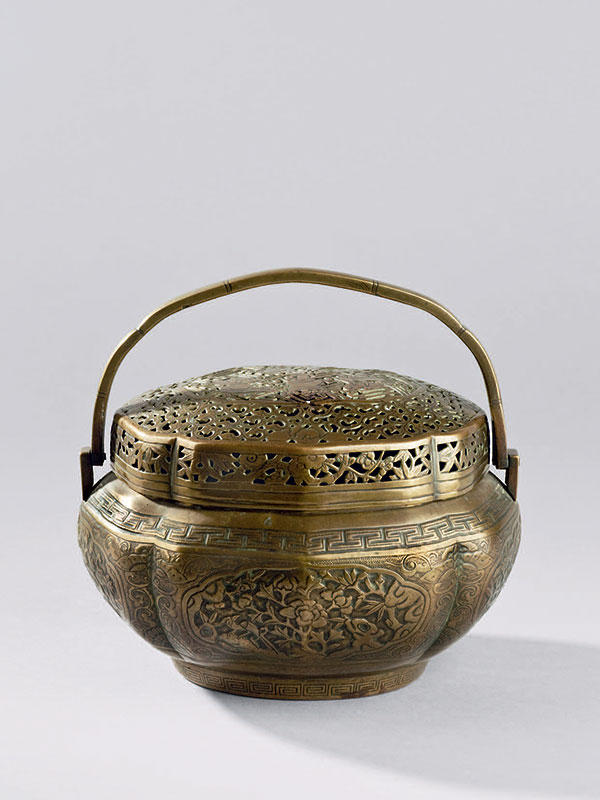Copper hand warmer
A copper hand warmer, the rounded, lobed body tapering upwards from a short foot with recessed base, and with a domed, pierced cover. A split overhead hinged handle is attached to the body by two rectangular mounts. The domed sides are decorated in relief with four cartouches, each in the shape of a crab-apple flower, with two on the wider sides depicting peonies and birds among rocks, and the other two on the shorter sides depicting lilies. Between the cartouches are reserves filled with butterflies and chrysanthemums among tendrils. The pierced cover depicts three vases containing fungi within a framed cartouche, whilst the sides of the cover are decorated with plum blossoms radiating from branches. Around the base and below the neck are bands of key-fret pattern.
The floral decoration with chrysanthemum and butterflies indicates that this delicately made hand warmer was more than likely used by a lady. In winter, hand warmers were heated with coals and wrapped in the long cuffs of a lady’s formal robes. This type of portable hand warmer also indicates the Chinese custom of warding off the cold on an individual basis rather than by heating entire rooms or a house. For the scholar in need of digital flexibility for painting and writing, with the hands remaining ungloved, the hand warmer was an essential piece of winter paraphernalia.[1] This hand warmer, although it bears neither mark nor signature, can be attributed on the basis of style to the coppersmith Pan Xiang-feng, active in the Qianlong period, 1736 – 1795, whose hand warmers have the same shape, profile, and proportions, including the rare and distinctive vertical foot. Two comparable copper hand warmers are in the collection of Steven Hung & Lindy Chern; one decorated with an ‘eternal prosperity’ motif is of similar shape, decoration and size;[2] the other hand warmer has a similar motif and bears the mark of Pan Xiang.feng.[3] A further comparable copper hand warmer of similar shape and decoration, dated to the 18th century and also attributed to Pan Xiang-feng, is in the Clague Collection.[4]
- Moss, H and Tsang, G., Arts from the Scholar’s Studio, Oriental Ceramic Society, Hong Kong, 1986, no. 51, p. 252
- Huang, K.N. Chinese Incense Burners, the Collection of Steven Hung & Lindy Chern, The National Museum of History, Taipei, 2000, no. 4, p. 29
- Huang, K.N. no. 6, p. 31
- Mowry, R. D. China’s Renaissance in Bronze, the Robert H. Clague Collection of Later Chinese Bronzes, Phoenix Art Museum, 1993, no. 41, pp. 192.3


